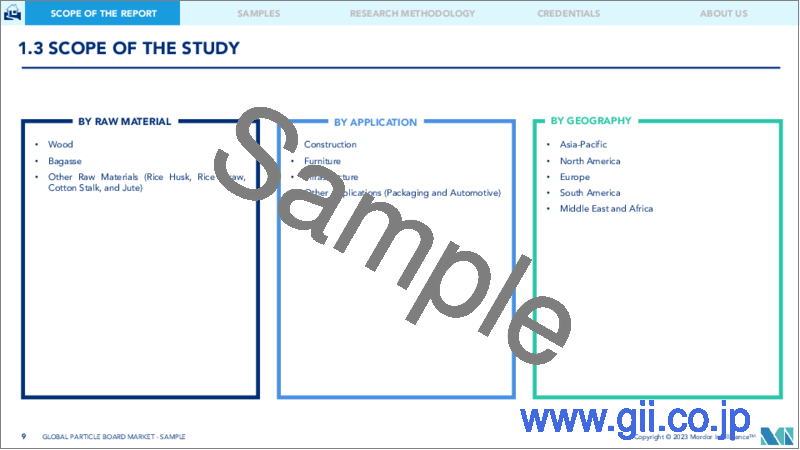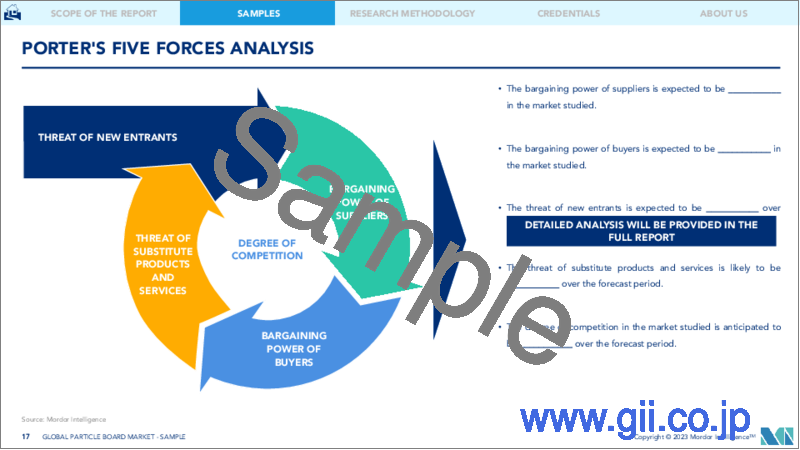|
|
市場調査レポート
商品コード
1197897
パーティクルボード市場- 成長、動向、予測(2023年~2028年)Particle Board Market - Growth, Trends, and Forecasts (2023 - 2028) |
||||||
|
● お客様のご希望に応じて、既存データの加工や未掲載情報(例:国別セグメント)の追加などの対応が可能です。 詳細はお問い合わせください。 |
|||||||
| パーティクルボード市場- 成長、動向、予測(2023年~2028年) |
|
出版日: 2023年01月23日
発行: Mordor Intelligence
ページ情報: 英文 120 Pages
納期: 2~3営業日
|
- 全表示
- 概要
- 目次
パーティクルボード市場は、予測期間中に5%を超えるCAGRで推移すると予測されています。
COVID-19の影響により、政府によっていくつかの制限が課されたため、建設活動が停止しています。COVID-19の大流行は、住宅建設の成長に深刻な打撃を与えると推測されます。しかし、2021年には状況が改善され、それによって市場の成長軌道を回復させました。
主なハイライト
- 長期的には、家具用パーティクルボードの需要増が市場の成長を後押ししています。
- 一方、代替品の中密度ファイバーボードの脅威が市場成長の妨げになると予想されます。
- パーティクルボードの新しい製造方法の開拓は、将来的に市場の機会として作用すると予測されています。
- 予測期間中、アジア太平洋地域が市場を独占すると予想されます。
パーティクルボードの市場動向
建設業界からの需要の増加
- 家具業界では、住宅やオフィス、アパートのインテリアに関するコンセプトが絶えず変化しています。このため、主にデザイン、サイズ、色などの面で、技術革新と開発が進んでいます。このため、世界中で家具の生産量が増加することが予想されます。
- 新しいオフィス建設の需要の増加は、床下地、キュービカルパーティション、壁パネル、偽天井、ドア、家具の需要の増加があるとして研究市場を後押しする可能性があります。さらに、既存のオフィスビルの改築や改装も、予測される時間内に製品の需要をサポートするために予測されています。
- 家具産業では、中国、米国、ドイツなどの国々が最大の市場を占めています。中国は、EUへの木製家具の圧倒的な輸出国です。
- 住宅都市農村開発省の予測によると、中国の建設部門は、2025年に向かって国のGDPの6%のシェアを維持することが期待されます。この予測を踏まえ、中国政府は2022年1月、建設部門をより持続可能で質の高いものにすることを主眼とした5カ年計画を発表しました。
- カナダ統計局によると、2022年6月のカナダにおける建築許可総額は1.5%減の119億米ドルであり、これは主に非住宅部門が10.4%減少したことが原因です。多世帯住宅の建築許可額は6.5%強化され、ミシソーガに複数のアパートが建設されたことにより、オンタリオ州(24.8%増)が主導権を握りました。
- 建築・建設部門は、メキシコ経済の屋台骨を支えています。都市化の進展と国民の所得水準の向上が、同国の建設需要を後押ししています。
- メキシコの住宅部門に提供される資金の大部分(約68%)は、メキシコ政府機関が担っています。CONAVI(国家住宅委員会)、INFONAVIT、FOVISSSTE、CFEなどの政府機関が、同国の住宅部門の成長を支えてきました。
- 米国では、住宅建設に対する公的支出が2017年の67.4億米ドルから2021年には90.6億米ドルに大きく増加しました。
- 上記のすべての要因が、予測期間中の世界市場を牽引すると予想されます。
アジア太平洋地域が市場を独占する
- アジア太平洋地域は、中国、インド、その他の国々における建設および家具産業の増加により、パーティクルボード市場の力強い成長を示すことになります。
- 中国は、人口増加、所得向上、急速な都市化により、アジア太平洋地域で最大の市場基盤となっています。また、ほぼすべての産業の主要な製造拠点の1つでもあります。そのため、中国のインフラ整備は今後も継続的に行われるでしょう。
- 中国の建設業が急速に発展したのは、中央政府が経済成長を維持するためにインフラ投資を推し進めたからです。
- インド政府は、約13億人に住まいを提供することを目標に、住宅建設を積極的に推進しています。今後7年間で約1兆3,000億米ドルの住宅投資が見込まれており、国内では新たに6,000万戸の住宅が建設される見通しです。
- 今年末までに、インドは、住宅などの手頃な価格の住宅に関する政府の取り組みにより、建設業界に約6,400億米ドルの貢献が期待されています。すべての計画に対して、です。
- インドの建設部門は同国第2位の産業であり、GDPに大きな割合を占めています。パンデミック蔓延時に成長の激減を経験したインドの建設部門は、2021年、公共・民間投資の急成長で立ち直っています。統計プログラム実施省によると、2022年第1四半期の建設部門のGDPシェアは453.9億米ドルに達し、2021年第4四半期のGDPシェア358.4億米ドルを上回っています。
- タイの住宅セクターの成長を後押ししたのは、2021年第3四半期に着工した5つの大規模な住宅プロジェクトです。これらのプロジェクトの完成予定は、2024年から2025年にかけてです。
- この地域における建設活動の増加と、インテリアに人工木材製品を使用する傾向の高まりは、パーティクルボードの需要の増加につながり、その結果、アジア太平洋地域で研究されている市場の成長を牽引しています。
その他の特典
- エクセル形式の市場予測(ME)シート
- アナリストによる3ヶ月間のサポート
目次
第1章 イントロダクション
- 調査の前提条件
- 調査範囲
第2章 調査手法
第3章 エグゼクティブサマリー
第4章 市場力学
- 促進要因
- 家具産業からの需要増加
- 原材料の入手しやすさ
- 抑制要因
- 代替品の中密度繊維板(MDF)の脅威
- 業界バリューチェーン分析
- ポーターファイブフォース
- 供給企業の交渉力
- 消費者の交渉力
- 新規参入業者の脅威
- 代替品の脅威
- 競合の度合い
第5章 市場セグメンテーション(金額ベース市場規模)
- 原材料
- 木材
- おがくず
- 削り屑
- フレーク
- 切粉
- バガス
- その他原材料
- 木材
- 用途
- 建築・土木
- 家具
- インフラ
- その他の用途
- 地域別
- アジア太平洋地域
- 中国
- インド
- 日本
- 韓国
- その他アジア太平洋地域
- 北米
- 米国
- カナダ
- メキシコ
- 欧州
- ドイツ
- 英国
- イタリア
- フランス
- その他欧州
- 南米
- ブラジル
- アルゼンチン
- その他の南米地域
- 中東・アフリカ
- サウジアラビア
- 南アフリカ共和国
- その他の中東地域
- アジア太平洋地域
第6章 競合情勢
- M&A、ジョイントベンチャー、提携、契約
- 市場シェア分析(%)
- リーディングプレイヤーが採用する戦略
- 企業プロファイル
- Associate Decor Ltd
- Boise Cascade
- Century Prowud
- D&R Henderson Pty Ltd
- EGGER
- Georgia-Pacific
- Kastamonu Entegre
- Krifor Industries Pvt. Ltd
- Peter Benson(Plywood)Limited
- Roseburg Forest Products
- Shirdi Industries Ltd.(ASIS India)
- Siam Riso Wood Products Co. Ltd
- Timber Products Company
- Uniboard
- West Fraser
- Wanhua Ecoboard Co. Ltd
第7章 市場機会と今後の動向
- パーティクルボード製造のための新工法の開発
- 今後の建設・インフラプロジェクト
The particle board market is projected to register a CAGR greater than 5 % during the forecast period.
Due to the impact of COVID-19, several restrictions have been imposed by the government, and thus, construction activities have come to a halt. The COVID-19 pandemic is estimated to hit residential construction growth severely. However, the conditions improved in 2021, thereby restoring the growth trajectory of the market studied.
Key Highlights
- Over the long term, the major factor driving the market is an increase in demand for particle boards for furniture is augmenting the growth of the market.
- On the flip side, the threat of medium-density fiberboard as a substitute is anticipated to hinder the growth of the market studied.
- The development of new methods to manufacture particle boards is projected to act as an opportunity for the market in the future.
- The Asia-Pacific region is expected to dominate the market during the forecast period.
Particle Board Market Trends
Increasing Demand from the Construction Industry
- In the furniture industry, concepts related to the interiors of homes, offices, and flats are changing continuously. This is driving innovation and development, primarily in terms of designs, size, and colors. This is expected to augment the production volume of furniture across the world.
- The increase in demand for new office construction is likely to boost the market studied as there is an increase in demand for flooring underlayment, cubical partitioning, wall paneling, false ceiling, doors, and furniture. Furthermore, renovation and refurbishment of the existing office buildings are also anticipated to support the product demand in the projected time.
- Countries including China, the United States, and Germany account for the largest markets in the furniture industry. China is the dominant exporter of wood furniture to the EU.
- As per the forecast given by the Ministry of Housing and Urban-Rural Development, China's construction sector is expected to maintain a 6% share of the country's GDP going into 2025. Keeping in view the given forecasts, the Chinese government unveiled a five-year plan in January 2022 focused on making the construction sector more sustainable and quality-driven.
- According to Statistics Canada, in June 2022, the total value of building permits in Canada decreased by 1.5% to USD 11.9 billion, primarily due to a 10.4% fall in non-residential sectors. The value of multi-family building permits was enhanced by 6.5%, with Ontario (+24.8%) taking the lead due to several apartment buildings being built in Mississauga.
- The building and construction sector is the backbone of the Mexican economy. The increasing urbanization and public income levels fuel the demand for construction in the country.
- The Mexican government bodies are responsible for most of the funds (around 68%) provided to the housing sector in Mexico. The government agencies, such as CONAVI (National Housing Commission), INFONAVIT, FOVISSSTE, and CFE, have been supporting the growth of the housing sector in the country.
- In the United States, public spending on residential construction increased significantly from 6.74 USD billion in 2017 to 9.06 USD billion in 2021.
- All the above-mentioned factors are expected to drive the global market during the forecast period.
Asia-Pacific Region to Dominate the Market
- The Asia-Pacific region is to witness robust growth in the particle board market, owing to the increasing construction and furniture industry in countries like China, India, and others.
- China is the largest market base in the Asia-Pacific region, owing to its ever-increasing population, rising income, and rapid urbanization. It is also one of the major manufacturing hubs for almost every industry. Hence, the infrastructure development in the country will see a continuous rise.
- China's construction industry developed rapidly due to the central government's push for infrastructure investment to sustain economic growth.
- The Indian government has been actively boosting housing construction, as it aims to provide a home to about 1.3 billion people. The country is likely to witness around USD 1.3 trillion of investment in housing over the next seven years and is likely to witness the construction of 60 million new homes in the country.
- By the end of this year, India is expected to contribute about USD 640 billion to the construction industry due to government initiatives in affordable housing, such as housing, to all plans.
- India's construction sector is the second-largest industry in the country, contributing a significant share of its GDP. After experiencing a drastic fall in growth during the pandemic spread, the Indian construction sector, in 2021, rebounded with a sharp growth in public and private investments. As per the Ministry of Statistics and Programme Implementation, the construction sector contributed a GDP share amounting to USD 45.39 billion in Q1 2022, which was higher than the GDP share of USD 35.84 billion contributed in Q4 2021.
- The propelling growth in Thailand's residential sector resulted from five major residential projects that started construction in the third quarter of 2021. The timelines for the completion of these projects revolve around 2024 to 2025.
- The growing construction activities in the region and the rising trend of using engineered wood products in interiors lead to an increase in the demand for particle board, which as a result, drives the growth of the market studied in the Asia-Pacific region.
Particle Board Market Competitor Analysis
The particle board market is fragmented in nature, due to the presence of several major players in different countries. Some of the major players (not in any particular order) in the market include West Fraser, Roseburg Forest Products, Georgia-Pacific, Wanhua Ecoboard Co. Ltd and Kastamonu Entegre.
Additional Benefits:
- The market estimate (ME) sheet in Excel format
- 3 months of analyst support
TABLE OF CONTENTS
1 INTRODUCTION
- 1.1 Study Assumptions
- 1.2 Scope of the Study
2 RESEARCH METHODOLOGY
3 EXECUTIVE SUMMARY
4 MARKET DYNAMICS
- 4.1 Drivers
- 4.1.1 Increasing Demand from the Furniture Industry
- 4.1.2 Easy Availability of Raw Materials
- 4.2 Restraints
- 4.2.1 Threat of Medium-density Fiberboard (MDF) as a Substitute
- 4.3 Industry Value Chain Analysis
- 4.4 Porter Five Forces
- 4.4.1 Bargaining Power of Suppliers
- 4.4.2 Bargaining Power of Consumers
- 4.4.3 Threat of New Entrants
- 4.4.4 Threat of Substitute Products and Services
- 4.4.5 Degree of Competition
5 MARKET SEGMENTATION (Market Size in Value)
- 5.1 Raw Material
- 5.1.1 Wood
- 5.1.1.1 Sawdust
- 5.1.1.2 Shavings
- 5.1.1.3 Flakes
- 5.1.1.4 Chips
- 5.1.2 Bagasse
- 5.1.3 Other Raw Materials
- 5.1.1 Wood
- 5.2 Application
- 5.2.1 Construction
- 5.2.2 Furniture
- 5.2.3 Infrastructure
- 5.2.4 Other Applications
- 5.3 Geography
- 5.3.1 Asia-Pacific
- 5.3.1.1 China
- 5.3.1.2 India
- 5.3.1.3 Japan
- 5.3.1.4 South Korea
- 5.3.1.5 Rest of Asia-Pacific
- 5.3.2 North America
- 5.3.2.1 United States
- 5.3.2.2 Canada
- 5.3.2.3 Mexico
- 5.3.3 Europe
- 5.3.3.1 Germany
- 5.3.3.2 United Kingdom
- 5.3.3.3 Italy
- 5.3.3.4 France
- 5.3.3.5 Rest of Europe
- 5.3.4 South America
- 5.3.4.1 Brazil
- 5.3.4.2 Argentina
- 5.3.4.3 Rest of South America
- 5.3.5 Middle East & Africa
- 5.3.5.1 Saudi Arabia
- 5.3.5.2 South Africa
- 5.3.5.3 Rest of Middle East & Africa
- 5.3.1 Asia-Pacific
6 COMPETITIVE LANDSCAPE
- 6.1 Mergers and Acquisitions, Joint Ventures, Collaborations, and Agreements
- 6.2 Market Share Analysis(%) **
- 6.3 Strategies Adopted by Leading Players
- 6.4 Company Profiles
- 6.4.1 Associate Decor Ltd
- 6.4.2 Boise Cascade
- 6.4.3 Century Prowud
- 6.4.4 D&R Henderson Pty Ltd
- 6.4.5 EGGER
- 6.4.6 Georgia-Pacific
- 6.4.7 Kastamonu Entegre
- 6.4.8 Krifor Industries Pvt. Ltd
- 6.4.9 Peter Benson (Plywood) Limited
- 6.4.10 Roseburg Forest Products
- 6.4.11 Shirdi Industries Ltd. (ASIS India)
- 6.4.12 Siam Riso Wood Products Co. Ltd
- 6.4.13 Timber Products Company
- 6.4.14 Uniboard
- 6.4.15 West Fraser
- 6.4.16 Wanhua Ecoboard Co. Ltd
7 MARKET OPPORTUNITIES AND FUTURE TRENDS
- 7.1 Development of New Methods to Manufacture Particle Boards
- 7.2 Upcoming Construction and Infrastructure Projects




